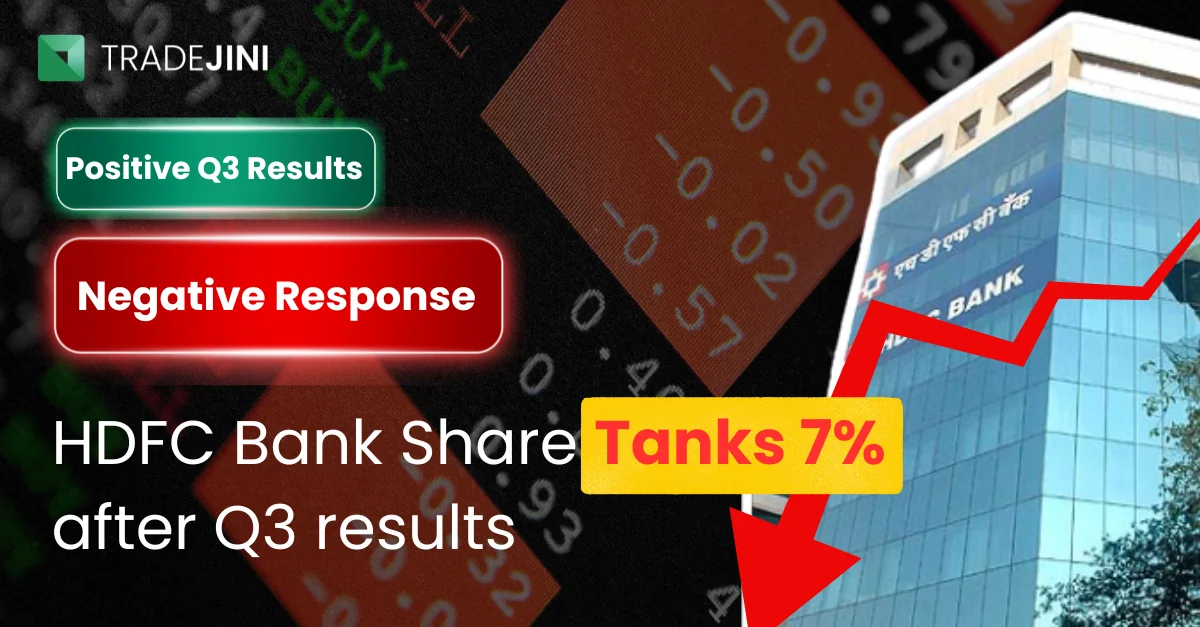In a surprising twist, HDFC Bank, one of India's largest private sector lenders, witnessed a sharp 7% drop in its share price in early trading on January 17, 2024, despite announcing robust third-quarter results. On January 16, the bank reported a significant 33% increase in net profit for the October-December quarter of the fiscal year 2023-24, alongside a substantial 24% growth in net interest income.
This dichotomy between the bank’s strong financial performance and the market's reaction poses an intriguing scenario, prompting a closer examination of the underlying factors.
Overview of Q3 Results: Impressive Growth but Market Skeptical
Robust Financial Performance
HDFC Bank's third-quarter results painted a picture of robust growth. The bank reported a net profit of ₹16,372 crore, marking a 33% increase from the ₹12,259 crore reported in the same period last year. This leap in profits is particularly noteworthy given the challenging economic environment.
Strong Growth in Net Interest Income
Equally impressive was the bank’s net interest income, which came in at ₹28,470 crore for the December quarter, registering a 24% increase year-on-year. This rise is indicative of HDFC Bank’s strong core income growth, driven by a healthy increase in advances and a steady net interest margin.
Comparative Market Performance
However, despite these strong results, HDFC Bank's performance in the stock market has been somewhat subdued compared to broader market indices. Over the past three months, HDFC Bank shares gained just over 9%, and around 5.5% over the past year. In contrast, the Nifty 50 rallied by 12% in three months and surged more than 23% in one year. The Bank Nifty, too, outpaced HDFC Bank with a 9% rise in three months and a 14.5% increase over the year.
The Disconnect
This discrepancy between HDFC Bank’s financial performance and its share price movement raises questions. The bank’s strong Q3 results would typically be a catalyst for a positive market response, yet the shares experienced a significant downturn. This unusual market behavior warrants a deeper analysis to understand the investors' perspective and the factors contributing to this surprising reaction.

In-Depth Look at HDFC Bank’s Financial Health
Asset Quality and Loan Growth
An integral aspect of HDFC Bank's financial stability is its asset quality. The bank reported a slight increase in gross non-performing assets (NPAs) to 1.26% from 1.23% last year. However, net NPAs showed a marginal improvement, standing at 0.31% compared to 0.33% in the previous year. This mixed picture of asset quality, though broadly stable, might have influenced investor sentiment.
The bank's loan portfolio showed robust growth, with a significant expansion in segments like retail, commercial, and rural loans. This diversification and growth in the loan book indicate the bank's aggressive strategy in capturing market share across various segments.
Capital Adequacy and Liquidity
HDFC Bank's capital adequacy ratio, as per Basel III guidelines, stood at a comfortable 18.4% as of the end of December, well above the regulatory requirement. This strong capital base positions the bank favorably for future growth and is a reassuring sign for investors concerned about the bank’s ability to absorb shocks.

HDFC Bank's Future Outlook and Plans
Expansion and Diversification Plans
Looking ahead, HDFC Bank is not resting on its laurels. The bank aims to expand its branch network significantly, targeting over 13,000 branches in the next three to five years. This expansion strategy is a clear indication of the bank's commitment to growing its footprint and capturing a larger market share.
IPO of Non-Banking Arm
One of the key future plans is the IPO process of HDFC Bank’s non-banking arm, HDB Financial Services, expected to start in the coming months. The listing of this subsidiary could unlock significant value for HDFC Bank and is a development that investors are watching closely.
Approach Towards Unsecured Loans and AIFs
In response to RBI's recent regulations, HDFC Bank has taken a cautious approach towards unsecured loans, which has slightly impacted its capital due to higher risk weights. The bank's exposure to alternative investment funds (AIFs) stands at ₹1,220 crore, with provisions made for the same. These prudent measures, while impacting short-term profitability, reflect the bank's focus on maintaining a healthy balance sheet.

Market Reaction and Analyst Opinions
Immediate Market Response
The immediate reaction of the market to HDFC Bank's Q3 results was notably negative, with the bank's shares dropping 7% in early trading. This decline suggests that investors may have had higher expectations or specific concerns that were not addressed in the results announcement.
Analyst Perspectives
Market analysts and financial experts have offered various interpretations of HDFC Bank's Q3 performance and its impact on the share price. Some analysts point to the potential concerns over the bank's asset quality, particularly the slight increase in gross NPAs. Others speculate that the market might have anticipated more aggressive growth figures or specific strategic announcements that were not delivered.
Furthermore, there are opinions suggesting that external factors, such as broader economic trends or sector-specific dynamics, might have played a role in the share price movement. The mixed analyst views highlight the complexity of interpreting market reactions and underscore the need for investors to consider a range of factors beyond mere financial metrics.

Comparative Analysis with Competitors
Performance Against Other Banks
To put HDFC Bank's Q3 performance into perspective, it's helpful to compare it with other major private sector banks in India. While HDFC Bank has shown strong growth, some of its peers may have reported even higher growth rates or more aggressive strategic moves that caught the market's attention.
Competitive Advantages and Challenges
HDFC Bank's strong capital adequacy and robust growth in its loan portfolio are significant competitive advantages. However, the bank also faces challenges, such as managing asset quality and navigating the increasingly competitive landscape of the Indian banking sector. The bank's approach to expanding its branch network and the upcoming IPO of its non-banking arm are strategic moves that could further strengthen its competitive position.
Market Expectations
The comparative analysis also sheds light on market expectations. Investors might be comparing HDFC Bank's performance and strategies with those of its competitors, leading to varying responses in terms of stock price movements. Such comparisons are crucial in understanding the relative market positioning and future prospects of HDFC Bank in the highly competitive banking sector.
The analysis of HDFC Bank's Q3 results juxtaposed with its share price decline offers a multifaceted view of the bank's current status in the financial market. Despite reporting strong financial growth, the bank's stock experienced a notable drop, reflecting the complex interplay of investor expectations, market dynamics, and comparative performance.
Key Takeaways:
- HDFC Bank's robust financial performance in Q3, marked by significant growth in net profit and net interest income, highlights its solid operational strengths.
- The bank's cautious approach to asset quality, expansion plans, and the potential IPO of its non-banking arm underscore its strategic foresight.
- The market reaction, with a sharp decline in share price, indicates a disconnect between the bank’s performance and investor sentiment, possibly driven by unmet expectations or broader market trends.
Broader Implications for Investors
For investors and market watchers, this scenario underscores the importance of looking beyond raw financial numbers. The market's response to HDFC Bank's results reminds us that factors such as future growth prospects, competitive positioning, and external economic conditions play a critical role in shaping investor sentiment.
HDFC Bank's experience also offers insights into the broader Indian banking sector, a space where competition is intensifying, and investor expectations are evolving. The bank's strategies and market response could serve as indicators for trends within the sector, offering clues about what might drive success in this dynamic environment.
Disclaimer
This conclusion wraps up the analysis of HDFC Bank's Q3 results and the subsequent market response. It's important to remember that this analysis is for informational purposes only and should not be considered as investment advice. Investors should conduct their research and consult financial professionals before making investment decisions.



